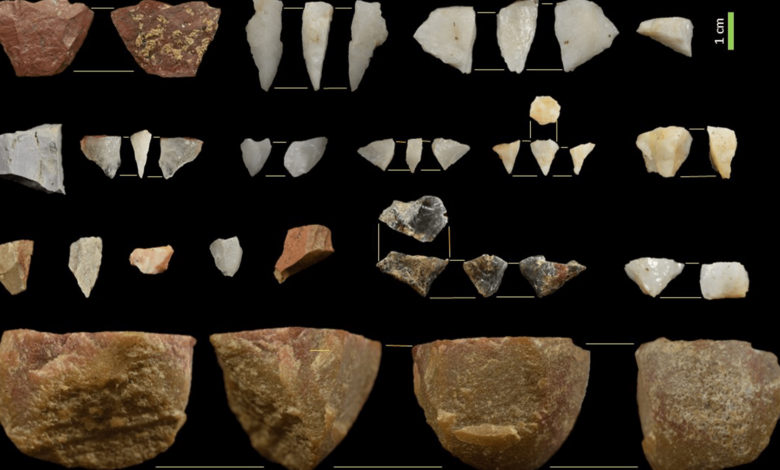Archaeologists hike up a cliff and find 20,000-year-old stone tools

The archeological team in South Africa made a remarkable discovery of stone tools dating back about 20,000 years. These tools were found in a cave perched 23 meters above sea level on the country’s southern coast. Despite the physical challenges of climbing up to the site with heavy excavation equipment, the team unearthed a treasure trove of artifacts that shed light on the lives of ancient inhabitants in the region.
Lead archeologist Sara Watson explained that the cave’s elevation played a crucial role in preserving the tools over thousands of years. The tools, which were carefully excavated and studied, provide valuable insights into how people in the area interacted and survived during a tumultuous period in Earth’s history.
The blades recovered from the cave were crafted during the Pleistocene era, a time marked by significant climatic changes as Earth transitioned from an ice age. Watson emphasized that the Pleistocene world was vastly different from the present, with fluctuating temperatures and dramatic shifts in climate posing challenges for early human populations.
The tools found in the cave offer clues about how ancient people adapted to their environment. The discovery of thousands of small, sharp blades and larger rock pieces used to craft these tools hints at innovative techniques for hunting and survival. The team’s meticulous excavation revealed intricate patterns of core reduction, indicating shared knowledge and social connections among ancient communities.
Interestingly, the methods used to create these tools were similar to those found in present-day Namibia and Lesotho, hundreds of miles away. This suggests a network of information exchange and collaboration among ancient populations, challenging the notion of isolated communities.
Watson speculates that the cave may have served as a temporary camp rather than a permanent settlement, further highlighting the dynamic nature of human habitation during that time. Despite the passage of millennia, the similarities between ancient tool-making techniques and modern practices underscore the continuity of human innovation and adaptability.
In conclusion, the archeological findings from the South African cave provide a glimpse into the lives of our distant ancestors and their ingenuity in crafting tools for survival. As researchers continue to unravel the mysteries of the past, these discoveries remind us of the enduring legacy of human resilience and creativity throughout history. During the last ice age, which occurred approximately 11,700 years ago, people living in that era were surprisingly similar to people today. Despite the vast differences in technology, lifestyle, and environment, the fundamental aspects of human behavior and culture remained consistent across time.
One of the key similarities between people living during the last ice age and modern humans is their social structure. Just like today, ancient societies were organized into groups or tribes with specific roles and responsibilities. These groups worked together to hunt, gather food, and protect each other, demonstrating the importance of cooperation and social bonds in both ancient and modern societies.
Additionally, people living during the last ice age exhibited similar cognitive abilities to modern humans. Archaeological evidence suggests that ancient humans were capable of complex problem-solving, creative thinking, and technological innovation. For example, they developed tools and weapons using materials found in their environment, showing a high level of adaptability and resourcefulness.
Furthermore, the cultural practices of people living during the last ice age were surprisingly advanced. They created intricate artworks, such as cave paintings and sculptures, which suggest a deep appreciation for aesthetics and symbolic expression. These artistic endeavors not only reflect the creativity of ancient humans but also highlight their capacity for self-expression and cultural identity.
Despite the harsh conditions of the last ice age, people living during that time exhibited resilience and adaptability. They developed strategies for surviving in extreme environments, such as building shelters, creating clothing from animal hides, and preserving food for long periods. These survival skills demonstrate the ingenuity and resourcefulness of ancient humans in the face of adversity.
In conclusion, the people living around the last ice age were not so different from people today. They exhibited similar social structures, cognitive abilities, cultural practices, and survival skills, highlighting the enduring qualities of human nature across time. By studying the lives of ancient humans, we can gain valuable insights into our own origins, behaviors, and capabilities as a species. In today’s fast-paced world, it can be easy to get caught up in the hustle and bustle of daily life. From work deadlines to social commitments, it can often feel like there’s never enough time in the day to truly relax and unwind. However, taking the time to prioritize self-care is crucial for maintaining both physical and mental well-being.
Self-care is defined as any intentional action taken to improve one’s physical, mental, or emotional health. This can encompass a wide range of activities, from getting enough sleep and eating well to engaging in hobbies and spending time with loved ones. The key is to make self-care a priority in your daily routine, rather than treating it as an afterthought.
One of the most important aspects of self-care is ensuring that you are getting enough rest. Sleep is essential for overall health and well-being, as it allows your body to repair and recharge. Aim to get at least 7-8 hours of sleep each night, and establish a bedtime routine that helps you unwind and relax before going to bed.
In addition to getting enough rest, it’s also important to pay attention to your diet and exercise habits. Eating a balanced diet rich in fruits, vegetables, and whole grains can help fuel your body and keep you feeling your best. Regular exercise is also crucial for maintaining physical health, as it can help reduce stress, improve mood, and boost energy levels.
Incorporating hobbies and activities that bring you joy and relaxation is another important aspect of self-care. Whether it’s reading a book, practicing yoga, or going for a walk in nature, taking the time to engage in activities that you enjoy can help reduce stress and improve overall well-being. Making time for yourself and prioritizing your own needs is not selfish – it is essential for maintaining a healthy and balanced lifestyle.
Finally, don’t forget to prioritize your mental and emotional health as well. This can involve seeking support from friends or loved ones, practicing mindfulness and meditation, or seeking professional help from a therapist or counselor. Taking care of your mental health is just as important as taking care of your physical health, and it’s important to prioritize both in your self-care routine.
In conclusion, self-care is essential for maintaining overall health and well-being. By prioritizing rest, nutrition, exercise, hobbies, and mental health, you can create a self-care routine that helps you feel your best and live your life to the fullest. Remember to make time for yourself and prioritize your own needs – your mind and body will thank you for it.




